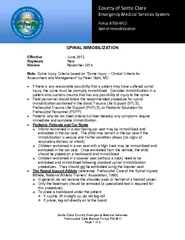

Consider imm obilization in a patient who sustains trauma that has any possibility of injury to the spine Field personnel should follow the recommended procedure for spinal immobilization contained in the Basic Trauma Life Support BTLS Prehospital T ID: 86621
Download Pdf The PPT/PDF document "Santa Clara County Emergency Medical Ser..." is the property of its rightful owner. Permission is granted to download and print the materials on this web site for personal, non-commercial use only, and to display it on your personal computer provided you do not modify the materials and that you retain all copyright notices contained in the materials. By downloading content from our website, you accept the terms of this agreement.
Santa Clara County Emergency Medical Services Prehospital Care Manual – P rotocol # 700 - M11 Page 1 of 3 P rotocol # 700 - M11 700 - M11 County of Santa Clara Emergency Medical Services System SPINAL MOTION RESTRICTION Effective: February 1 2 , 201 9 Replaces: February 2, 2016 Review: February 12, 2021 I. Purpose The purpose of this protocol is to provide a spinal injury assessment tool to assist the BLS and ALS prehospital provider in the determination of the most appropriate Spinal Motion R estriction (SMR) treatment of patients that may have sustaine d a spinal injury. II. Spinal Motion Restriction (SMR) A. Spinal Motion Restriction (SMR) begins with of the manual stabilization and immobilizat ion of the cervical spine, followed by the proper application of the following devices: 1. Properly sized rigid cervical collar, and; 2. Long plastic radio translucent spine board , and; 3. Web belt or strapping device, and; 4. Lateral h ead support device B. SMR will be applied to all patients that have or may have sustained a significant mechanism of injury and have an abnormal Spinal Injury Assessment, as described in Section III of this protocol. C. Modified Spinal Motion Restriction begins with the manual stabilization and immobilization of the cervical spine, followed by the application of, a t minimum, a rigid cervical collar and is utilized for a less acute patient with a simple mechanism of injury. D. Modified S MR is utilized when full SMR is not practical or is not best suited for the management of the patient’s special circumstances by restricting the gross motion of the spi ne with non - traditional methods. (i.e.; pt on gurney with collar) E. Modified SMR is utilize d for patient s that exhibit para - vertebral pain or soft tissue tenderness and has an unremarkable Spinal Injury Assessment, a s described in Section III of this protocol . III. Spinal Injury Assessment A. If the potential for a spinal injury exists , apply manual cervical stabilization and asses s the patient for the following: 1. Determine the patient is without a language barrier 2. Asses s for any distracting injuries and alcohol or drug use Santa Clara County Emergency Medical Services Prehospital Care Manual – P rotocol # 700 - M11 Page 2 of 3 POLICY #102 P rotocol # 700 - M11 3. Deter mine if the patient is cooperative, alert and ori entated 4. P alpate and visualize the entire vertebral column for injury B. If the above assessment is Abnormal at any step, apply SMR. C. If the above assessment is U nremarkable continue with exam: 1. Asses s for adequate circulation, motor, and sensation in all extremities 2. Asses s flexion and extension in both elbows and wrist 3. Asses s finger adduction and abduction in both hands 4. Asses s flexion and extension in both knees 5. Asses s p lantar flexion and dorsiflexion in both feet D. If the above assessment is Abnormal at any step, apply SMR. E. If the above assessment is Unremarkable consider Modified SMR or omit SMR. IV. Special Considerations of SMR A. The following factors should be considered in conjunction with the Sp inal Injury Assessment to determine the appropriate use of SMR or Modified SMR : 1. Patients over age fifty - five (55) have an increased risk of death from even moderate injuries 2. P ediatric patients sustain more head and multi - systems injuries than adults , due to the traumatic force applied to a child's body is distributed over less body mass 3. The presence of, cardiac, respiratory , end stage renal disease requiring dialysis , or metabolic disease are also factors that may merit the use of SMR with patients presenting moderate injuries B. Spinal immobilization has been found to limit p atient ’ s ability to ventilate and/or oxygenate. Consider the use of modified spinal im mobilization of geriatric an d pediatric patients with acute or chronic dyspnea. C. Infants restrained in a rear - facing car seat may be immobilized to the car seat and extricated in the car seat if his/her condition allows . D. Pediatrics restrained in a front facing car seat with a high back may be immobilized t o the car seat and extricated in the car seat . E. Pediatrics restrained in a booster seat without a back must be placed in SMR . Consider the use of a padded pediatric motion restricting boards, if available. F. Avoid methods that provoke increased spinal move ment and/or agitation in combative patients. G. Patients with penetrating trauma to the head, neck, or torso and no evidence of spinal injury should not be immobilized on a backboard. Santa Clara County Emergency Medical Services Prehospital Care Manual – P rotocol # 700 - M11 Page 3 of 3 POLICY #102 P rotocol # 700 - M11 V. Treatment Flow Chart